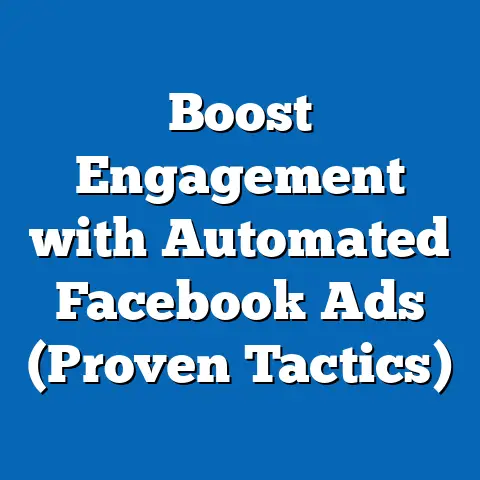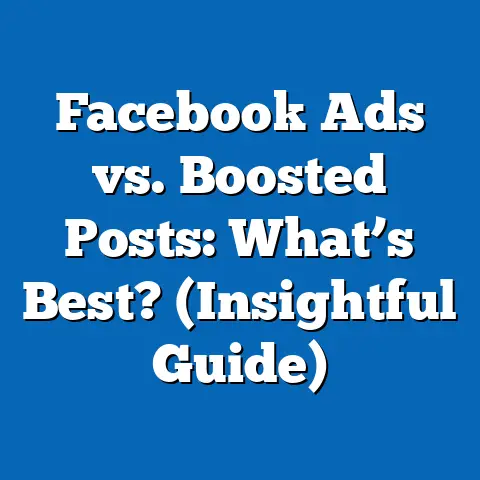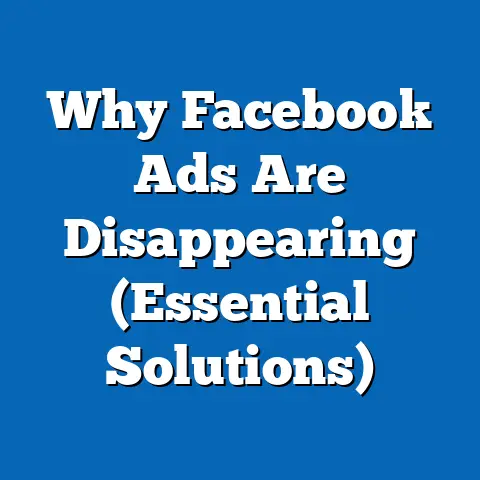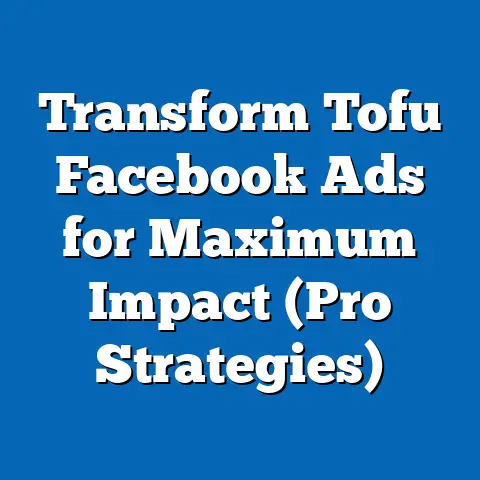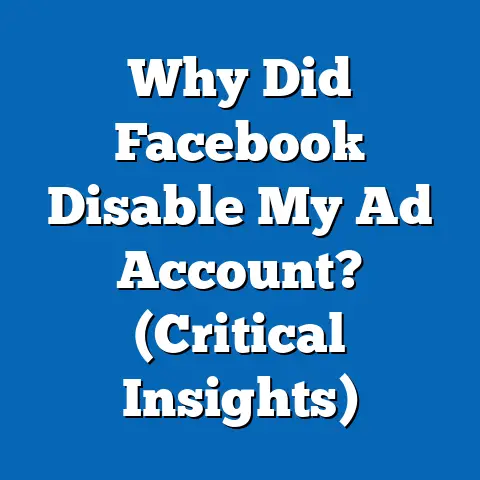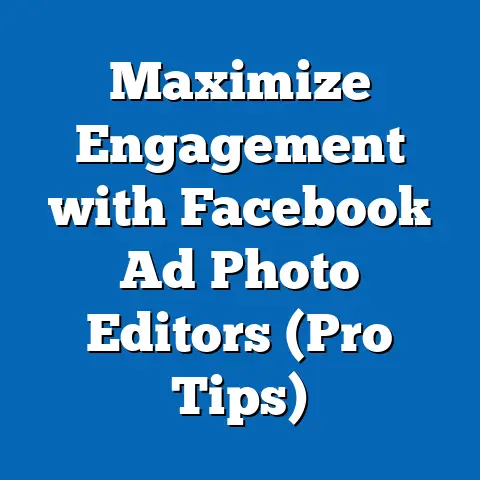Unlock Facebook Ad Boosting Secrets (Proven Strategies)
Facebook advertising. Just the phrase can evoke a mix of excitement and, let’s be honest, a little bit of dread. I remember when I first started running ads on Facebook – I felt like I was throwing money into a black hole! There were so many options, so many metrics, and so much jargon that it was overwhelming. But over the years, I’ve learned that Facebook advertising, when done right, can be an absolute game-changer for businesses of all sizes. It’s not just about boosting a post and hoping for the best; it’s about understanding the platform, crafting compelling content, and strategically targeting your audience.
Facebook has revolutionized how businesses connect with their audiences. Forget the days of static billboards and hoping the right eyes glanced your way. Facebook’s power lies in its unparalleled targeting capabilities. I’m talking granular demographics, laser-focused interests, and even behaviors that would make a mind reader jealous. It’s a platform where you can find your people, the ones who are genuinely interested in what you have to offer.
Section 1: Understanding the Facebook Ads Ecosystem
Before you even think about clicking that “Boost Post” button, it’s crucial to understand the landscape you’re about to enter. The Facebook Ads ecosystem is a complex, ever-evolving organism, but with a solid foundation, you can navigate it with confidence.
Overview of Facebook Ads
Facebook offers a diverse range of ad formats, each designed to cater to different objectives and capture attention in unique ways. I’ve found that choosing the right format is half the battle! Here’s a breakdown of some of the most popular options:
-
Image Ads: These are the simplest and often the most cost-effective way to get started. A single, compelling image paired with concise, persuasive copy can be surprisingly effective. I often use these for brand awareness campaigns or to promote simple offers.
-
Video Ads: Video is king! People are far more likely to engage with video content than static images. Use video ads to tell your brand story, showcase your product in action, or offer valuable tips and tutorials. I’ve seen incredible engagement rates with short, attention-grabbing video ads.
-
Carousel Ads: These ads allow you to showcase multiple images or videos in a single ad unit, each with its own headline, description, and link. I love using carousel ads to highlight different features of a product or to tell a sequential story.
-
Collection Ads: Designed for e-commerce, collection ads showcase a primary video or image above a selection of related products. This format provides a seamless shopping experience directly within Facebook.
-
Lead Ads: These ads are specifically designed to collect leads directly within the Facebook platform. They pre-populate user information, making it incredibly easy for people to sign up for your newsletter, request a quote, or download a resource. I’ve found these to be invaluable for building my email list.
Image Ads: These are the simplest and often the most cost-effective way to get started. A single, compelling image paired with concise, persuasive copy can be surprisingly effective. I often use these for brand awareness campaigns or to promote simple offers.
Video Ads: Video is king! People are far more likely to engage with video content than static images. Use video ads to tell your brand story, showcase your product in action, or offer valuable tips and tutorials. I’ve seen incredible engagement rates with short, attention-grabbing video ads.
Carousel Ads: These ads allow you to showcase multiple images or videos in a single ad unit, each with its own headline, description, and link. I love using carousel ads to highlight different features of a product or to tell a sequential story.
Collection Ads: Designed for e-commerce, collection ads showcase a primary video or image above a selection of related products. This format provides a seamless shopping experience directly within Facebook.
Lead Ads: These ads are specifically designed to collect leads directly within the Facebook platform. They pre-populate user information, making it incredibly easy for people to sign up for your newsletter, request a quote, or download a resource. I’ve found these to be invaluable for building my email list.
The benefits of each format vary, but understanding their strengths allows you to tailor your advertising efforts to your specific goals. For example, if you’re launching a new product, a carousel ad can showcase its features beautifully. If you’re trying to generate leads, a lead ad is your best bet.
The Importance of Targeting
This is where Facebook truly shines. I believe the power of Facebook advertising lies in its unmatched targeting capabilities. Gone are the days of broadcasting your message to everyone and hoping someone bites. Facebook lets you pinpoint your ideal customer with incredible precision.
Facebook’s targeting options are incredibly detailed. You can target users based on:
- Demographics: Age, gender, location, education, relationship status, job title – the basics, but still incredibly powerful.
- Interests: This is where things get interesting. Facebook tracks users’ interests based on the pages they like, the groups they join, and the content they interact with. This allows you to target people who are genuinely interested in your niche.
- Behaviors: Facebook tracks users’ online and offline behaviors, such as purchase history, travel habits, and device usage. This allows you to target people who are likely to be interested in your product or service.
- Custom Audiences: This is a game-changer. You can upload your existing customer data (email addresses, phone numbers) to create custom audiences. This allows you to target your existing customers with specific offers or to create lookalike audiences (more on that later).
I’ve had clients who were blown away by the level of detail they could target. One client, a local bakery, was able to target women aged 25-45 who were interested in baking, living within a 5-mile radius of their store. The results were incredible!
The Role of the Facebook Algorithm
Ah, the algorithm. The mysterious force that governs what users see in their newsfeeds. I remember spending countless hours trying to decipher its secrets! While it’s constantly evolving, understanding its core principles is crucial for ad success.
Facebook’s algorithm prioritizes content that it believes users will find engaging and relevant. This means that your ads need to be high-quality, visually appealing, and targeted to the right audience. Here’s how the algorithm impacts ad visibility:
-
Relevance Score: Facebook assigns a relevance score to each ad based on how well it resonates with the target audience. A high relevance score indicates that your ad is engaging and relevant, which leads to lower costs and better placement.
-
Bid Amount: Your bid amount also plays a role in ad visibility. The higher your bid, the more likely your ad is to be shown to your target audience. However, a high bid doesn’t guarantee success. You also need a high relevance score to compete effectively.
-
Ad Quality: Facebook prioritizes high-quality ads that provide a positive user experience. This means that your ads need to be visually appealing, informative, and free of misleading or deceptive content.
Relevance Score: Facebook assigns a relevance score to each ad based on how well it resonates with the target audience. A high relevance score indicates that your ad is engaging and relevant, which leads to lower costs and better placement.
Bid Amount: Your bid amount also plays a role in ad visibility. The higher your bid, the more likely your ad is to be shown to your target audience. However, a high bid doesn’t guarantee success. You also need a high relevance score to compete effectively.
Ad Quality: Facebook prioritizes high-quality ads that provide a positive user experience. This means that your ads need to be visually appealing, informative, and free of misleading or deceptive content.
Understanding the algorithm is an ongoing process. I recommend staying up-to-date on the latest Facebook news and algorithm updates to ensure that your ads are always optimized for success.
Key Takeaway: The Facebook Ads ecosystem is multifaceted, but mastering its core components, from understanding ad formats to leveraging targeting options and decoding the algorithm, is essential for successful ad boosting.
Section 2: Crafting Compelling Ad Content
You’ve identified your target audience, but now you need to grab their attention. Crafting compelling ad content is where the magic happens. It’s about creating visuals and copy that resonate with your audience and inspire them to take action.
Creating Eye-Catching Visuals
In the fast-paced world of social media, visuals are your first impression. I can’t stress enough how important it is to invest in high-quality images and videos. Here are some tips for designing eye-catching visuals:
- Use High-Resolution Images: Blurry or pixelated images are a major turn-off. Make sure your images are high-resolution and optimized for Facebook’s recommended dimensions.
- Choose Visually Appealing Colors: Colors can evoke emotions and grab attention. Choose colors that are consistent with your brand and that resonate with your target audience.
- Use Clear and Concise Graphics: If you’re using text in your visuals, make sure it’s easy to read and understand. Avoid cluttering your images with too much information.
- Showcase Your Product in Action: If you’re selling a product, show it in action! People want to see how your product works and how it can benefit them.
- Use Emotionally Engaging Imagery: Connect with your audience on an emotional level. Use images that evoke feelings of happiness, excitement, or inspiration.
I worked with a clothing brand that was struggling to get traction with their Facebook ads. Their images were low-quality and didn’t showcase their clothing in a flattering way. We invested in professional photography and saw an immediate improvement in ad performance.
Writing Persuasive Copy
Your visuals may grab attention, but your copy seals the deal. Persuasive ad copy is concise, clear, and compelling. Here are some tips for writing effective ad copy:
- Know Your Audience: Speak directly to your target audience. Use language that they understand and that resonates with their interests and needs.
- Highlight the Benefits: Focus on the benefits of your product or service, not just the features. Tell people how your product can solve their problems or improve their lives.
- Use Strong Action Verbs: Start your sentences with strong action verbs to grab attention and inspire action. Examples include “Discover,” “Learn,” “Get,” “Try,” and “Join.”
- Create a Sense of Urgency: Encourage people to take action now by creating a sense of urgency. Use phrases like “Limited Time Offer,” “Sale Ends Soon,” or “Don’t Miss Out.”
- Include a Clear Call-to-Action (CTA): Tell people exactly what you want them to do. Use clear and concise CTAs like “Shop Now,” “Learn More,” “Sign Up Today,” or “Download Now.”
Let’s look at some examples of successful ad copy:
- Example 1 (E-commerce): “Shop our new summer collection! Get 20% off your first order with code SUMMER20. Shop Now!”
- Example 2 (Lead Generation): “Download our free ebook on the top 10 marketing strategies for 2024. Learn how to grow your business and attract new customers. Download Now!”
- Example 3 (Brand Awareness): “Discover the difference with [Your Brand]. We’re committed to providing high-quality products and exceptional customer service. Learn More!”
A/B Testing for Optimization
A/B testing, also known as split testing, is the process of comparing two versions of an ad to see which performs better. I consider this a crucial part of any successful Facebook ad campaign. It allows you to make data-driven decisions about your ad content and optimize for maximum impact.
Here’s how to conduct A/B testing:
- Choose a Variable to Test: Select one element of your ad to test, such as the headline, image, CTA, or target audience.
- Create Two Versions of Your Ad: Create two versions of your ad that are identical except for the variable you’re testing.
- Run Your Ads Simultaneously: Run both versions of your ad simultaneously to ensure that they’re exposed to the same conditions.
- Track Your Results: Monitor the performance of each ad and track key metrics like reach, engagement, CTR, and conversion rate.
- Analyze Your Data: Analyze the data to determine which version of your ad performed better.
- Implement Your Findings: Implement your findings by using the winning ad version in your future campaigns.
I remember running an A/B test on a client’s ad campaign where we tested two different headlines. One headline focused on the product’s features, while the other focused on the benefits. The headline that focused on the benefits outperformed the other by a significant margin.
Key Takeaway: Compelling ad content is the cornerstone of successful Facebook ad boosting. By investing in high-quality visuals, crafting persuasive copy, and conducting A/B testing, you can create ads that resonate with your audience and drive results.
Section 3: Budgeting and Bidding Strategies
You have your killer ad content ready to go, but how much should you spend? And how do you ensure that you’re getting the most bang for your buck? Let’s dive into the world of budgeting and bidding strategies.
Setting a Budget
Determining an appropriate budget for your Facebook ads can feel like a guessing game, but it doesn’t have to be. I’ve found that a strategic approach based on your business goals, target audience, and competitive landscape is the most effective.
Here are some factors to consider when setting your budget:
- Business Goals: What are you trying to achieve with your Facebook ads? Are you trying to increase brand awareness, generate leads, drive sales, or something else? Your budget should align with your goals.
- Target Audience: How large is your target audience? The larger your audience, the more you’ll need to spend to reach them effectively.
- Competition: How competitive is your industry? If you’re in a highly competitive industry, you’ll need to spend more to stand out from the crowd.
- Ad Relevance: As discussed earlier, a high relevance score can significantly reduce your ad costs. Focus on creating high-quality, targeted ads to improve your relevance score and lower your budget.
- Campaign Duration: Are you running a short-term campaign or a long-term campaign? Your budget should be adjusted accordingly.
I recommend starting with a small budget and gradually increasing it as you see results. This allows you to test your ads and optimize your targeting without breaking the bank.
Understanding Bidding Options
Facebook offers a variety of bidding strategies, each designed to help you achieve different goals. I’ve learned that understanding these options is crucial for maximizing your ROI. Here are some of the most common bidding strategies:
- Cost-Per-Click (CPC): You pay each time someone clicks on your ad. This is a good option if you’re trying to drive traffic to your website or landing page.
- Cost-Per-Impression (CPM): You pay for every 1,000 impressions of your ad. This is a good option if you’re trying to increase brand awareness.
- Cost-Per-Action (CPA): You pay when someone takes a specific action, such as making a purchase or signing up for your newsletter. This is a good option if you’re trying to generate leads or drive sales.
- Daily Unique Reach: Facebook will attempt to show your ad to as many unique people as possible, once per day. This is good for broad reach campaigns.
The best bidding strategy for you will depend on your business goals and your target audience. I recommend experimenting with different bidding strategies to see which performs best for you.
Monitoring and Adjusting Budgets
Setting your budget is just the first step. I’ve found that continuous monitoring and adjustment are essential for maximizing your ROI.
Here are some tips for monitoring and adjusting your budgets:
- Track Your Results: Regularly monitor your ad performance and track key metrics like reach, engagement, CTR, and conversion rate.
- Identify Underperforming Ads: Identify ads that are underperforming and make adjustments. This could involve changing the ad copy, visuals, or targeting.
- Scale Successful Ads: If you have ads that are performing well, consider scaling them by increasing your budget or expanding your targeting.
- Use Facebook’s Budget Optimization Tools: Facebook offers a variety of budget optimization tools, such as campaign budget optimization (CBO), which can help you automatically allocate your budget to the best-performing ad sets.
I once worked with a client who was running a Facebook ad campaign for a new product launch. Their initial budget was $100 per day, but they weren’t seeing the results they wanted. After analyzing their data, we discovered that one of their ad sets was significantly outperforming the others. We increased the budget for that ad set and saw a dramatic improvement in their overall campaign performance.
Key Takeaway: Budgeting and bidding strategies are essential for maximizing your ROI on Facebook ads. By setting a budget that aligns with your business goals, understanding your bidding options, and continuously monitoring and adjusting your budgets, you can ensure that you’re getting the most bang for your buck.
Section 4: Leveraging Facebook Insights and Analytics
Data is your best friend in the world of Facebook advertising. I believe that leveraging Facebook Insights and Analytics is the key to unlocking continuous improvement and maximizing your ROI.
Using Facebook Ads Manager
Facebook Ads Manager is your central hub for creating, managing, and tracking your Facebook ad campaigns. I think of it as my mission control for all things Facebook advertising! It provides a wealth of data and insights that can help you optimize your ads for maximum performance.
Here are some of the key features of Facebook Ads Manager:
- Campaign Dashboard: Provides an overview of your overall campaign performance, including reach, engagement, CTR, and conversion rate.
- Ad Set Dashboard: Provides detailed information about the performance of each ad set, including targeting, budget, and bidding.
- Ad Dashboard: Provides detailed information about the performance of each individual ad, including impressions, clicks, and conversions.
- Reporting Tools: Allows you to create custom reports to track your ad performance over time.
- A/B Testing Tools: Provides tools for conducting A/B testing to optimize your ad content.
I recommend spending time familiarizing yourself with Facebook Ads Manager and exploring its various features. The more you understand the tool, the better equipped you’ll be to analyze your data and make informed decisions.
Interpreting Data for Improvement
Collecting data is one thing, but interpreting it and using it to improve your campaigns is another. I’ve found that understanding the key metrics and how they relate to each other is crucial for making data-driven decisions.
Here are some of the key metrics to monitor:
- Reach: The number of unique people who saw your ad.
- Impressions: The number of times your ad was displayed.
- Click-Through Rate (CTR): The percentage of people who clicked on your ad after seeing it.
- Conversion Rate: The percentage of people who took a desired action (e.g., made a purchase, signed up for your newsletter) after clicking on your ad.
- Cost-Per-Click (CPC): The average cost you paid for each click on your ad.
- Cost-Per-Conversion (CPC): The average cost you paid for each conversion.
- Relevance Score: A measure of how well your ad resonates with your target audience.
By monitoring these metrics and analyzing your data, you can identify areas for improvement and optimize your ads for maximum performance. For example, if your CTR is low, you may need to improve your ad copy or visuals. If your conversion rate is low, you may need to improve your landing page or offer.
Implementing Insights into Future Campaigns
The ultimate goal of data analysis is to use your insights to inform your future advertising efforts. I believe that continuous learning and improvement are essential for long-term success with Facebook advertising.
Here are some strategies for implementing insights into future campaigns:
- Refine Your Targeting: Use your data to refine your targeting and ensure that you’re reaching the right audience.
- Improve Your Ad Content: Use your data to improve your ad copy, visuals, and CTAs.
- Optimize Your Bidding Strategy: Use your data to optimize your bidding strategy and ensure that you’re getting the most bang for your buck.
- Test New Ideas: Use your data to identify new ideas to test in your future campaigns.
I worked with a client who was running a Facebook ad campaign for a new mobile app. After analyzing their data, we discovered that their ads were performing significantly better on mobile devices than on desktop computers. We adjusted their targeting to focus exclusively on mobile users and saw a dramatic improvement in their campaign performance.
Key Takeaway: Facebook Insights and Analytics are your secret weapons for optimizing your ad campaigns. By using Facebook Ads Manager, interpreting your data, and implementing your insights into future campaigns, you can continuously improve your results and maximize your ROI.
Section 5: Advanced Strategies for Facebook Ad Boosting
You’ve mastered the basics, but now it’s time to take your Facebook ad boosting to the next level. Let’s explore some advanced strategies that can help you achieve even greater success.
Retargeting Campaigns
Retargeting is a powerful strategy that allows you to re-engage users who have previously interacted with your brand. I consider it essential for capturing those “almost” customers who showed interest but didn’t quite convert.
Here’s how retargeting works:
- Install the Facebook Pixel: The Facebook Pixel is a small piece of code that you install on your website. It tracks user behavior on your site, such as page views, product views, and purchases.
- Create a Custom Audience: Use the Facebook Pixel data to create a custom audience of people who have visited your website or taken specific actions.
- Create a Retargeting Ad: Create a retargeting ad that is specifically tailored to the people in your custom audience.
For example, you could create a retargeting ad that shows a product to people who viewed it on your website but didn’t add it to their cart. Or you could create a retargeting ad that offers a discount to people who abandoned their shopping cart.
I’ve seen incredible results with retargeting campaigns. One client, an online clothing store, was able to increase their sales by 20% by implementing a retargeting campaign that showed abandoned cart reminders to their website visitors.
Utilizing Lookalike Audiences
Lookalike audiences are a powerful way to expand your reach to new potential customers who are similar to your existing customers. I think of them as a cloning tool for your best customers!
Here’s how to create a lookalike audience:
- Create a Source Audience: Choose a source audience to base your lookalike audience on. This could be your existing customer list, your website visitors, or your Facebook page fans.
- Choose a Lookalike Size: Choose the size of your lookalike audience. The smaller the size, the more closely the lookalike audience will resemble your source audience.
- Create Your Lookalike Audience: Facebook will use its data to create a lookalike audience of people who are similar to the people in your source audience.
You can then use your lookalike audience to target new potential customers with your Facebook ads. I’ve found that lookalike audiences are particularly effective for reaching people who are likely to be interested in your product or service but who haven’t yet heard of your brand.
Integrating Facebook Ads with Overall Marketing Strategy
Facebook ads are most effective when they’re integrated with your overall marketing strategy. I believe that a cohesive, multi-channel approach is the key to building a strong brand and driving long-term growth.
Here are some ways to integrate your Facebook ads with your other marketing efforts:
- Email Marketing: Use your Facebook ads to drive traffic to your email signup form. Then, use email marketing to nurture your leads and convert them into customers.
- Content Marketing: Use your Facebook ads to promote your blog posts, articles, and other content. This can help you drive traffic to your website and establish yourself as an authority in your industry.
- Social Media Marketing: Use your Facebook ads to promote your other social media channels. This can help you grow your following and increase engagement across all of your social media platforms.
I worked with a client who was running a Facebook ad campaign to promote a new webinar. They also sent out an email to their existing subscribers and promoted the webinar on their other social media channels. As a result, they had a record number of attendees at their webinar.
Key Takeaway: Advanced strategies like retargeting, lookalike audiences, and integrating Facebook ads with your overall marketing strategy can help you take your Facebook ad boosting to the next level. By implementing these strategies, you can achieve even greater success and maximize your ROI.
Conclusion
Unlocking the secrets to effective Facebook ad boosting is an ongoing journey that requires experimentation, adaptation, and continuous learning. I’ve shared with you the proven strategies that have helped me and my clients achieve success, from understanding the Facebook Ads ecosystem to crafting compelling ad content, mastering budgeting and bidding, leveraging Facebook Insights, and implementing advanced strategies like retargeting and lookalike audiences.
The key takeaway is this: Facebook advertising is not a “set it and forget it” activity. It requires constant attention, analysis, and optimization. Don’t be afraid to experiment with different ad formats, targeting options, and bidding strategies. Track your results, analyze your data, and make adjustments as needed.
Remember, the Facebook algorithm is constantly evolving, so it’s important to stay up-to-date on the latest news and trends. By staying informed and continuously learning, you can ensure that your Facebook ads are always optimized for success.
I encourage you to apply the proven strategies outlined in this guide to your Facebook advertising efforts and track your results. I’m confident that by following these strategies, you can enhance your Facebook advertising efforts and achieve better results. Now go out there and start boosting your way to success! And remember, I’m always here to help if you need any further guidance. Good luck!

